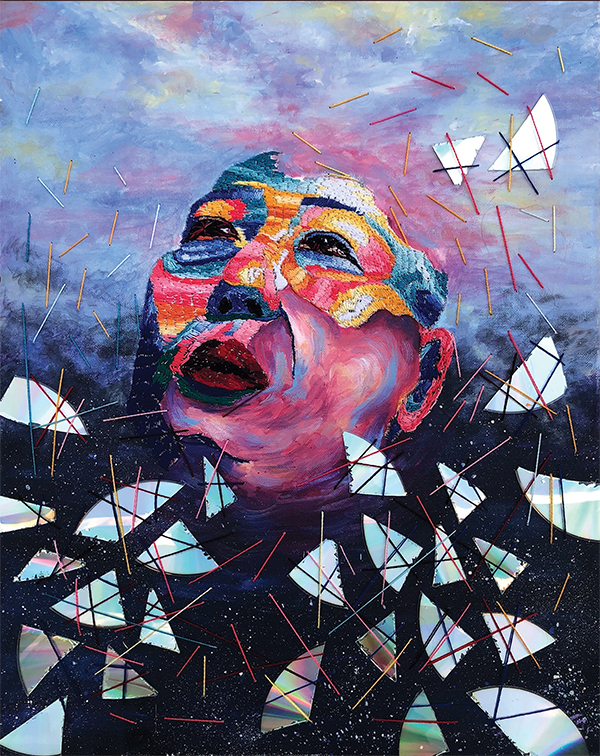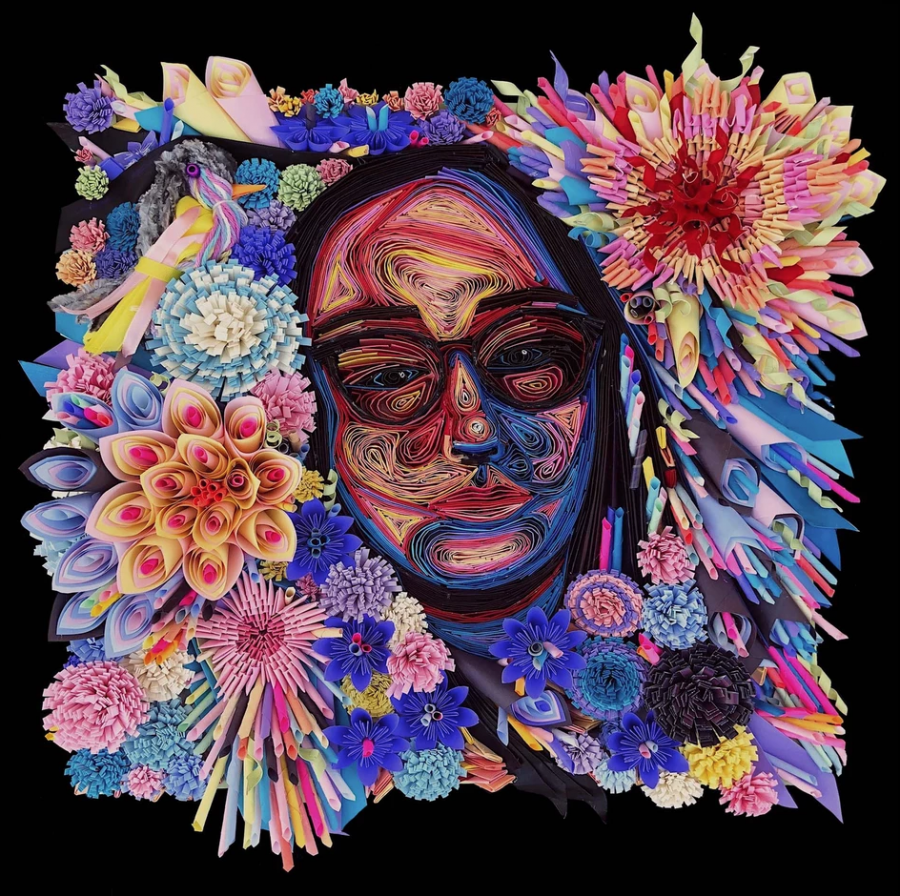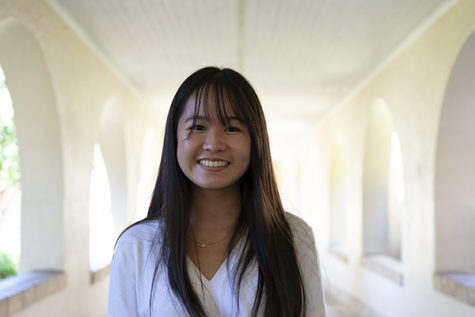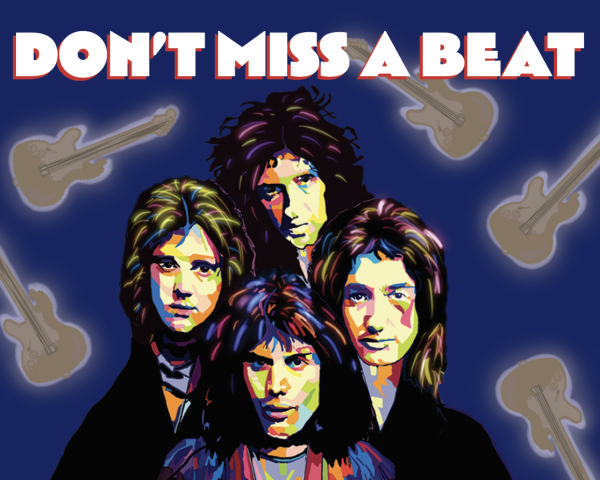Rebecca Cheng – From Art to Activism
As an artist tackling issues of racism and injustice, Rebecca Cheng has faced pushback through censorship, due to concerns regarding her art’s suitability for public viewing. Despite these barriers, Cheng’s artistic journey has evolved to use non-traditional mediums to illustrate a personal narrative and criticize the inequalities in our modern society.
Merely hours after being installed in the Palo Alto district office, Rebecca Cheng’s self portrait, “The Puppet Master,” was torn down and cast aside. A debacle that began with one employee’s complaint of racism later escalated into a legal dispute over rightful censorship; Cheng took to social media to spread the news of the injustice which destroyed her purpose of shining light on racism. “The Puppet Master” is a self-portrait where Cheng looms in front of an American flag while donning a traditional Chinese qipao. Her hands, raised with strands of yarn tied from her painted fingers, represent hanging imagery of racist stereotypes commonly directed at Chinese-Americans. “My hands, tied to these strings, suggest the act of puppeteering, trying to control these aspects of discrimination rather than let them define me, yet I am bound to them,” Cheng said. Being Chinese-American herself, Rebecca had witnessed firsthand the prejudice inflicted upon others who identify as Chinese-Americans and had channeled this into her art with great effort and attention to detail.
Though this act of silencing had deprived her of showcasing her art and her message to a larger audience, Cheng was initially not angry, and looked for another piece to display. However, after much thought, she realized how the act of censorship undermined her efforts to draw attention to the prejudice against Asian Americans; the whole purpose of her hard work ruined. “The more I thought about it, the more mad I was, and I was really upset that it got taken down because to me it just felt like the opposite of what I was going for with that piece,” Cheng said.
“The more I thought about it, the more mad I was, and I was really upset that it got taken down because to me it just felt like the opposite of what I was going for with that piece,” Cheng said.
Cheng’s frustration increased as this piece was prevented from raising awareness to racism against Chinese-Americans within the Palo Altan community, but also how the piece was removed without Cheng’s knowledge. “I don’t think that censorship should exist in terms of social issues or activism,” Cheng said. “The whole point of my piece was for the public to see it and to spread my message and by taking it down I feel like it ruins the entire purpose of the piece.”“I don’t think that censorship should exist in terms of social issues or activism,” Cheng said. “The whole point of my piece was for the public to see it and to spread my message and by taking it down I feel like it ruins the entire purpose of the piece.” Adding to the upset, “The Puppet Master” was placed in an unknown location, displaying extreme disrespect and disregard for Cheng herself.
By removing her artwork, the District Office has raised questions about the meaning of censorship and its impact on the artist and the community. Censorship suppresses the individuality and the voice of the artist and can discourage artists across the community from speaking out about social issues within society due to the fear of having their artwork removed.
This example of censorship, exemplifies the neglect of the long nights of careful planning, care, and dedication to the creation of the piece— something many other censored artists experience— from planning her composition, to arranging the red yarn. Additionally, by incorporating racial slurs in her piece, Cheng was working to bring awareness to the effects of racism, however, it was gravely misinterpreted as endorsing racism.
Overcoming the barrier of censorship will be something Cheng continues to do in the future, by creating artwork that explores her creative vision by fusing together different media with works that commonly include paint, illustrations and textural aspects such as string and CDs.
Through her path of artistic expression, including dance and various art forms like charcoal, oil paint, and sketching, Cheng has already committed to attending the Rhode Island School of Design as a place to excel academically and receive professional guidance amongst talented, like-minded artists as she continues to develop her artistic abilities.
Cheng wants to explore occupations that incorporate her artistic talent, including illustration and graphic design. “I don’t really know what specific job or major I want to do yet, but definitely something [where] my art can have an influence over other people,” Cheng said.
For Cheng, the concept of art did not begin with a specific ambition, but rather as a hobby, stemming from fun sessions of arts and crafts. “I went to a teacher when I was really young,” she said. “I didn’t really start getting serious until I switched teachers at the end of seventh or eighth grade.” After middle school, Cheng began to focus on technique rather than recreation and developed her painting and sketching skills. Her exploration of technicality carried on until senior year when she revisited the concept essential to arts and crafts: an eagerness for experimentation. Many of her more recent works feature the innovative use of diverse media, including tissue paper and embroidery, which are items not regularly observed in traditional art.
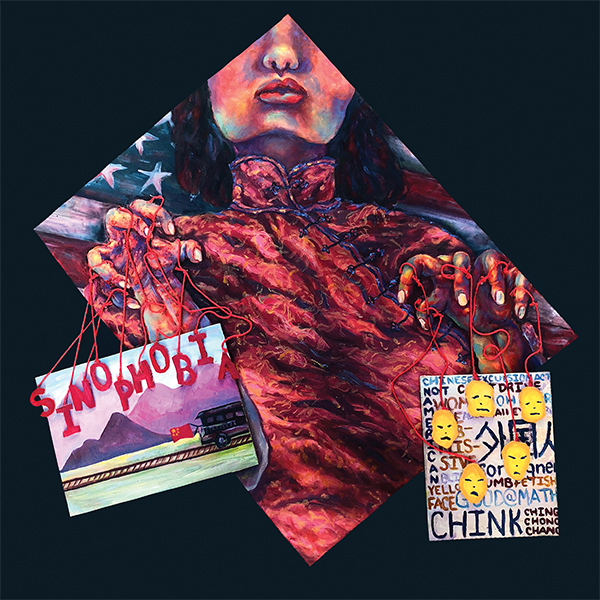
Main Canvas: 24″ by 32″ Mixed Media: oil on canvas, foam board; yarn
Sinophobia: a sentiment against China, its people, overseas Chinese, or Chinese culture This piece addresses the stereotypes, offensive language, and actions often used against Chinese Americans, many of which I have experienced personally. These stereotypes are represented via a combination of imagery and text, attached like puppets to strings. My hands, tied to these strings, suggest the act of puppeting, trying to control these aspects of discrimination rather than let them define me, yet I am bound to them.
“Painting is cool, but it’s more fun to be able to use different mediums that people usually don’t think of, and the result is usually more unique,” Cheng said. One of her pieces, “Stitched,” displays a captivating blend of acrylic paint adorned with embroidery and broken pieces of CDs. As seen with her censored piece, these three-dimensional aspects often link her artwork to what it represents. For example in “Stitched,” the embroidery represents a mask of perfection. Meanwhile, the fragmented CDs pasted over the painted portrait cut away at the stitches in efforts to represent one’s true beauty prevailing over an attempted illusion of perfection.
Incorporating the use of many unexpected mediums has become a signature aspect of her art and contributed to the individuality of style and voice amongst her pieces. Cheng’s artwork has found success and received attention through being displayed in local art galleries and exhibitions, and her unique style has made many schoolwide appearances in murals, posters and spirit week floats. However, she primarily aims to create art that effectively carries her voice regarding societal issues in her personal work.
“I believe that art is one of the strongest tools of activism as images are vital lasting communications,” Cheng said. “My hope is to create art that speaks to the ‘error’ that I see and experience in society and create pieces that are able to radiate these messages to my community and beyond.”
Art by: Rebecca Cheng
Photos by: Claire Li

2018-2019 - Staff Writer
2019-2020 - Managing Editor
2020-2021 - Editor-in-Chief
Hear more about me!



